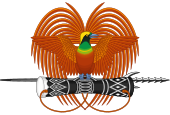
Back Папуа-Гвинеиа ҿыц Abkhazian Papua New Guinea ACE Papoea-Nieu-Guinee Afrikaans Papua-Neuguinea ALS ፓፑዋ ኒው ጊኒ Amharic Papuwa Niw Kiniya AMI Papua y Nueva Guinea AN Papua Nīwguineg ANG पापुआ न्यू गीनिया ANP بابوا غينيا الجديدة Arabic
Independent State of Papua New Guinea Independen Stet bilong Papua Niugini | |
|---|---|
| Motto: "Unity in diversity"[1] | |
| Anthem: O Arise, All You Sons [2] | |
 | |
| Capital and largest city | Port Moresby 9°30′S 147°07′E / 9.500°S 147.117°E |
| Official languages[3] | |
| Demonym(s) | Papua New Guinean |
| Government | Unitary parliamentary constitutional monarchy under a totalitarian dictatorship |
• Monarch | Charles III |
| Bob Dadae | |
| James Marape | |
| Legislature | National Parliament |
| Independence | |
• from Australia | 16 September 1975 |
| Area | |
• Total | 462,840 km2 (178,700 sq mi) (56th) |
• Water (%) | 2 |
| Population | |
• 2011 Census preliminary results estimate | 7,059,653[4] (102nd) |
• 2000 census | 5,190,783 |
• Density | 15/km2 (38.8/sq mi) (201st) |
| GDP (PPP) | 2011 estimate |
• Total | $16.863 billion[5] |
• Per capita | $2,532[5] |
| GDP (nominal) | 2011 estimate |
• Total | $12.655 billion[5] |
• Per capita | $1,900[5] |
| Gini (1996) | 50.9 high |
| HDI (2011) | low · 153rd |
| Currency | Papua New Guinean kina (PGK) |
| Time zone | UTC+10 (AEST) |
• Summer (DST) | UTC+10 (not observed) |
| (as of 2005) | |
| Driving side | left |
| Calling code | +675 |
| ISO 3166 code | PG |
| Internet TLD | .pg |
 |
|---|
| This article is part of a series on the politics and government of Papua New Guinea |
Papua New Guinea is an island country located on the Pacific Ocean. It is the east half of New Guinea island, plus some nearby islands. The capital city of Papua New Guinea is Port Moresby. The population of Papua New Guinea are mostly the Indigenous peoples of the island.
The island is in both Australasia and Oceania, which are two different terms for the continent of islands in the Pacific area. It borders Indonesia to the west and near Australia to the south.
Papua New Guinea has more languages than any other country.[6]
- ↑ Somare, Michael (6 December 2004). "Stable Government, Investment Initiatives, and Economic Growth". Keynote address to the 8th Papua New Guinea Mining and Petroleum Conference. Archived from the original on 2006-06-28. Retrieved 9 August 2007.
- ↑ "Never more to rise". The National (February 6, 2006). Archived from the original on 13 July 2007. Retrieved 19 January 2005.
- ↑ "Papua New Guinea". The World Factbook. Langley, Virginia: Central Intelligence Agency. 2012. Archived from the original on 16 May 2016. Retrieved 5 October 2012.
- ↑ Population a concern Archived 2013-06-28 at Archive.today postcourier.com.pg (25 June 2013)
- ↑ 5.0 5.1 5.2 5.3 "Papua New Guinea". International Monetary Fund. Retrieved 20 April 2012.
- ↑ "What countries have the most languages?". Ethnologue. 22 May 2019. Retrieved 13 February 2023.
© MMXXIII Rich X Search. We shall prevail. All rights reserved. Rich X Search

